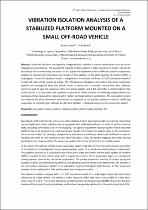 ResearchSpace
ResearchSpace
Vibration isolation analysis of a stabilized platform mounted on a small off-road vehicle
JavaScript is disabled for your browser. Some features of this site may not work without it.
- ResearchSpace
- →
- Research Publications/Outputs
- →
- Conference Publications
- →
- View Item
| dc.contributor.author |
Strydom, Anria

|
|
| dc.contributor.author |
Els, PS

|
|
| dc.date.accessioned | 2014-09-30T13:19:06Z | |
| dc.date.available | 2014-09-30T13:19:06Z | |
| dc.date.issued | 2014-06 | |
| dc.identifier.citation | Strydom, A and Els, P.S. 2014. Vibration isolation analysis of a stabilized platform mounted on a small off-road vehicle. In: 9th South African Conference on Computational and Applied Mechanics, Somerset West, 14–16 January 2014 | en_US |
| dc.identifier.uri | http://hdl.handle.net/10204/7696 | |
| dc.description | 9th South African Conference on Computational and Applied Mechanics, Somerset West, 14–16 January 2014 | en_US |
| dc.description.abstract | Stabilised platforms are regularly integrated with vehicles in various applications such as terrain mapping and surveillance. The equipment installed on the platform is often sensitive to motion and has to be isolated from unnecessary vibrations. In this paper the implementation of different platform suspension systems to improve the orientation and motion of the platform in the pitch degrees of freedom (DOF) is investigated. A one DOF platform model is merged with a validated, nonlinear, 12 DOF simulation model of a small off-road vehicle known as a Baja. The effectiveness of passive, semi-active and active suspension systems are investigated when the vehicle model is excited by a sinusoidal road profile input. Skyhook control is used to vary the damping in the semi-active system, and a PID controller is implemented in the active system. It is concluded that a passive suspension is ineffective due to conflicting spring stiffness and damping settings required for reduced pitch motion and level platform orientation. The semi-active system can improve the pitch orientation and motion as compared to the passive suspension without conflicting suspension or controller gain settings, but the best solution is obtained using an active suspension system. | en_US |
| dc.language.iso | en | en_US |
| dc.publisher | SACAM 2014 | en_US |
| dc.relation.ispartofseries | Workflow;13447 | |
| dc.subject | Stabilised platforms | en_US |
| dc.subject | Terrain mapping | en_US |
| dc.subject | Surveillance | en_US |
| dc.title | Vibration isolation analysis of a stabilized platform mounted on a small off-road vehicle | en_US |
| dc.type | Conference Presentation | en_US |
| dc.identifier.apacitation | Strydom, A., & Els, P. (2014). Vibration isolation analysis of a stabilized platform mounted on a small off-road vehicle. SACAM 2014. http://hdl.handle.net/10204/7696 | en_ZA |
| dc.identifier.chicagocitation | Strydom, Anria, and PS Els. "Vibration isolation analysis of a stabilized platform mounted on a small off-road vehicle." (2014): http://hdl.handle.net/10204/7696 | en_ZA |
| dc.identifier.vancouvercitation | Strydom A, Els P, Vibration isolation analysis of a stabilized platform mounted on a small off-road vehicle; SACAM 2014; 2014. http://hdl.handle.net/10204/7696 . | en_ZA |
| dc.identifier.ris | TY - Conference Presentation AU - Strydom, Anria AU - Els, PS AB - Stabilised platforms are regularly integrated with vehicles in various applications such as terrain mapping and surveillance. The equipment installed on the platform is often sensitive to motion and has to be isolated from unnecessary vibrations. In this paper the implementation of different platform suspension systems to improve the orientation and motion of the platform in the pitch degrees of freedom (DOF) is investigated. A one DOF platform model is merged with a validated, nonlinear, 12 DOF simulation model of a small off-road vehicle known as a Baja. The effectiveness of passive, semi-active and active suspension systems are investigated when the vehicle model is excited by a sinusoidal road profile input. Skyhook control is used to vary the damping in the semi-active system, and a PID controller is implemented in the active system. It is concluded that a passive suspension is ineffective due to conflicting spring stiffness and damping settings required for reduced pitch motion and level platform orientation. The semi-active system can improve the pitch orientation and motion as compared to the passive suspension without conflicting suspension or controller gain settings, but the best solution is obtained using an active suspension system. DA - 2014-06 DB - ResearchSpace DP - CSIR KW - Stabilised platforms KW - Terrain mapping KW - Surveillance LK - https://researchspace.csir.co.za PY - 2014 T1 - Vibration isolation analysis of a stabilized platform mounted on a small off-road vehicle TI - Vibration isolation analysis of a stabilized platform mounted on a small off-road vehicle UR - http://hdl.handle.net/10204/7696 ER - | en_ZA |





